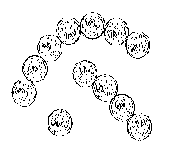The text on this site is presented as an
archival version of the script of "Ocean
Planet," a 1995 Smithsonian Institution
traveling exhibition. The content reflects the
state of knowledge at the time of the exhibition,
and has not been updated.

Biological Roulette
For centuries, people have transplanted locally native
marine species to new areas. In some cases the introductions are
intentional: animals are imported for fish farming. Most
introductions are unintentional and unfortunate. In their new
homes, hitchhikers and stowaways often turn into
troublemakers §.
Ballast water brings unwanted passengers aboard §. Ships take
on ballast water to adjust their position in the water or to
improve maneuverability and stability. When ships drain ballast
water, plants and animals picked up elsewhere may survive and
move into new territory.
Click on the wheel to see how some alien species were introduced, and what happened


Alexandrium catenella
From:Japan
To: Australia
Effect: Caused red tides, contaminated seafood
How introduced: Stowaway brought in ballast water
Illustration © Tim Phelps

Troublemakers
Zebra mussels muscle in in the Great Lakes §
The most famous or infamous ballast-water stowaway is the zebra
mussel. Originally from Europe, it now flourishes, to say the
least, in the Great Lakes: 700,000 zebra mussels may occupy only
1 cubic yard. Mussel damage to industries, public utilities,
navigation, boating, and sport fishing could total $5 billion by
the year 2000.

Zebra mussels clog a water intake pipe, Detroit Edison's Monroe
Plant
photo © Ron Peplowski, courtesy of Detroit Edison
More information:
Asian clams take the advantage
in San Francisco Bay §
In 1986, just after a flood lowered populations of native San
Francisco Bay clams and mussels, the Asian clam, Potamocorbula
amurensis, arrived in ballast water. Within two years, there
were more than 12,000 Asian clams per square meter in some areas.
Now the Asian clam population, along with 150 other introduced
species, could alter the bay's entire food web.

Golden Gate Bridge, San Francisco Bay
photo © David W. Hamilton/The Image Bank

Precautions
Guidelines get rid of stowaways
In 1991, the International Maritime Organization (a United
Nations agency) developed voluntary guidelines for ballast water.
All participating major and medium-sized shipping nations will
take measures to control the spread of alien species. §
 Algal bloom
Algal bloom
International Maritime Organization guidelines advise ships to
avoid taking on ballast water in heavily silted areas or waters
with algal blooms. §
photo © Norbert Wu
Other Resources:
 Ocean Planet Exhibition Floorplan
Ocean Planet Exhibition Floorplan

 gene carl feldman (gene@seawifs.gsfc.nasa.gov) (301) 286-9428
gene carl feldman (gene@seawifs.gsfc.nasa.gov) (301) 286-9428
Judith Gradwohl, Smithsonian Institution (Curator/Ocean Planet)


![]()


![]()
![]() Ocean Planet Exhibition Floorplan
Ocean Planet Exhibition Floorplan
![]()